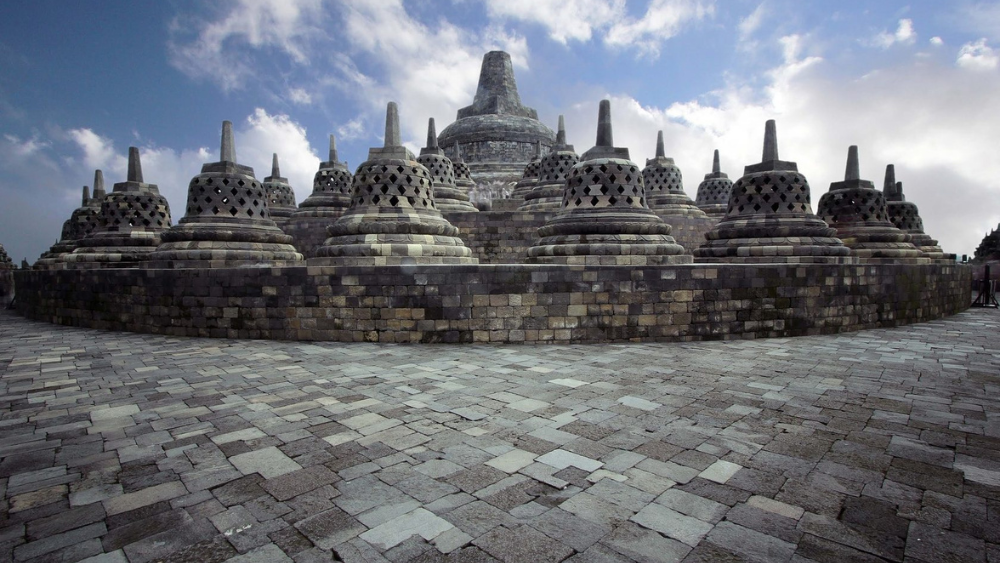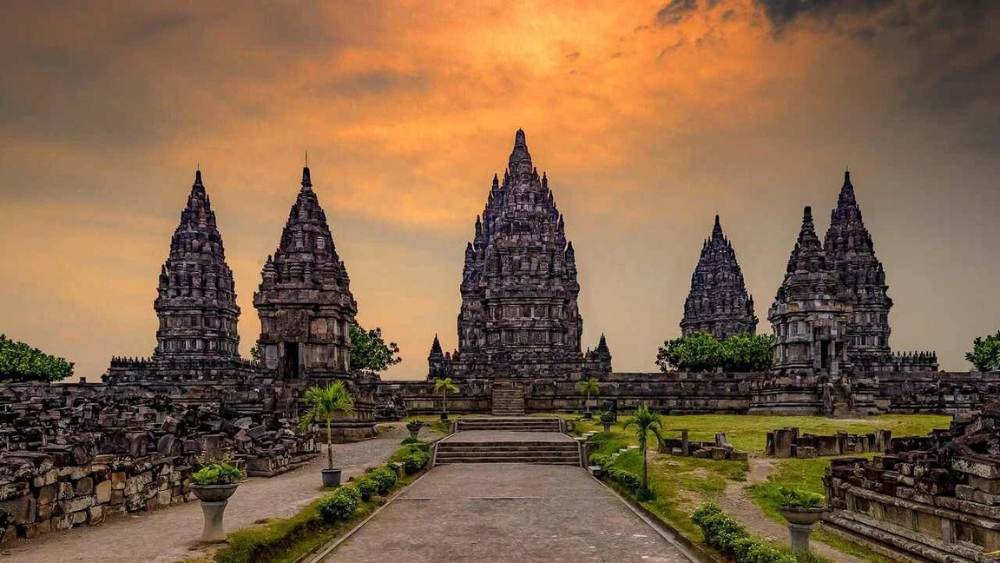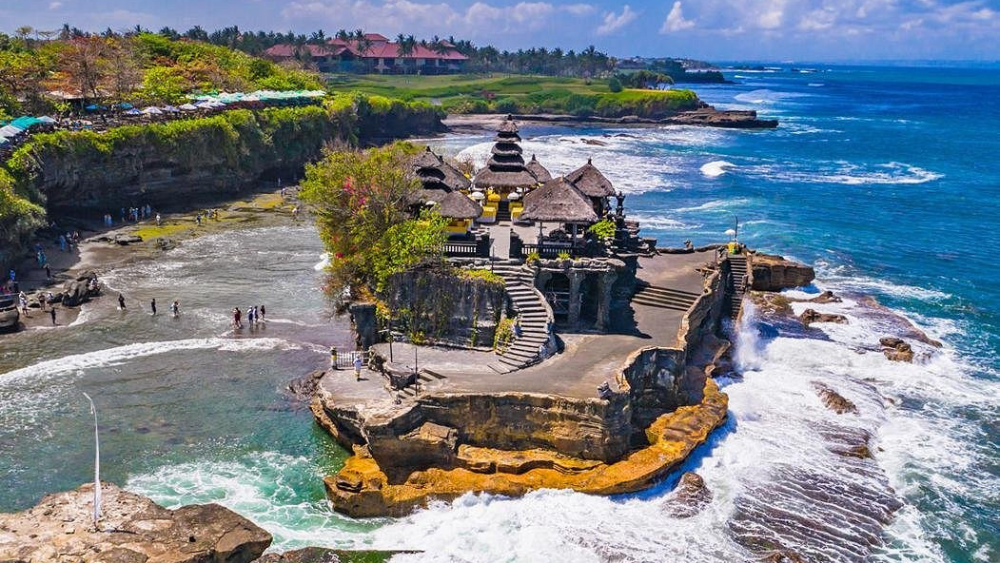The Complete guide for Temples in Indonesia
Table of Contents
Introduction
Famous Temples in Indonesia, from Borobudur to Tanah Lot. Explore history, culture, and spirituality with travel tips, best times to visit & more. Indonesia, an enchanting archipelago, is renowned for its breathtaking landscapes, rich cultural heritage, and diverse religious traditions. The country is home to some of the world’s most magnificent temples, representing a blend of Hindu, Buddhist, and indigenous influences. These temples, scattered across the islands, showcase Indonesia’s deep spiritual roots and artistic excellence.
Temples in Indonesia are not just places of worship but also serve as historical landmarks that tell the stories of ancient kingdoms, cultural evolution, and religious devotion. Each temples in indonesia, from the grandeur of Borobudur, the world’s largest Buddhist temple, to the spiritual serenity of Pura Besakih, known as Bali’s “Mother Temple,” holds unique significance. They attract millions of visitors, including pilgrims, historians, and travelers seeking to immerse themselves in the spiritual and artistic essence of Indonesia.
The architectural brilliance of these temples is a testament to the craftsmanship of past civilizations. Many structures feature intricate stone carvings, massive stupas, and tiered pagodas that reflect the influence of Hindu-Buddhist culture, as well as local artistic styles. Some temples, like Prambanan, have soaring spires symbolizing the connection between the divine and the earthly realms, while others, like Tanah Lot, are built on rocky outcrops surrounded by the sea, offering a mystical and awe-inspiring view.
Aside from their architectural splendor, temples in indonesia come alive during religious festivals and ceremonies. Celebrations such as Vesak at Borobudur, Galungan and Kuningan in Bali, and Nyepi (the Balinese Day of Silence) provide an opportunity for visitors to witness age-old traditions, processions, and sacred rituals performed with deep reverence. The temples become vibrant centers of devotion, uniting communities and offering travelers a unique cultural experience.
Whether you are drawn to temples in indonesia for their spiritual significance, historical importance, or artistic grandeur, these sacred sites promise an unforgettable journey into the heart of the country’s cultural and religious heritage. Exploring these temples offers not just a glimpse into Indonesia’s past but also a deeper understanding of its enduring traditions and beliefs.
History of Temples in Indonesia
The history of Indonesia’s temples is deeply rooted in the country’s religious and cultural evolution. The development of these sacred structures spans over a millennium, influenced by Hinduism, Buddhism, and later Islam. The temples stand as enduring monuments to Indonesia’s past rulers, artistic achievements, and spiritual devotion.
Early Hindu-Buddhist Influence (4th – 10th Century)
The earliest records of temples in Indonesia date back to the Tarumanagara and Kutai Kingdoms in the 4th century. Hinduism and Buddhism were introduced through trade routes linking India and Southeast Asia. These influences led to the construction of the first temple structures, mainly in Java and Sumatra.
By the 8th to 10th centuries, the rise of the Srivijaya Empire in Sumatra and the Medang Kingdom in Central Java saw the golden age of temple architecture. This period witnessed the construction of grand temples, including Borobudur and Prambanan, both of which remain among the most significant religious sites in the world. Borobudur, built during the reign of the Sailendra Dynasty, is the largest Buddhist temple globally, featuring intricate bas-reliefs depicting the life of Buddha. Prambanan, on the other hand, is a masterpiece of Hindu architecture, dedicated to the Trimurti – Brahma, Vishnu, and Shiva.
The Majapahit Era and the Expansion of Hindu Temples (13th – 15th Century)
During the 13th to 15th centuries, the Majapahit Empire in East Java marked another flourishing period for temple construction. Hinduism dominated this era, and many temples were built using red brick, showcasing a distinctive style. Some notable temples from this period include Penataran Temple in East Java and Candi Sukuh, which features unique pyramid-like structures influenced by local Javanese beliefs.
The Majapahit rulers also played a crucial role in spreading Hindu culture to Bali. While Hinduism gradually declined in Java due to the arrival of Islam, Bali remained a stronghold of Hindu traditions. Many of the island’s famous temples, such as Pura Besakih, were either established or expanded during this period, continuing the Majapahit legacy.
The Decline of Hindu-Buddhist Temples and the Rise of Islam (15th – 18th Century)
From the 15th century onwards, the spread of Islam across Java and Sumatra led to the decline of Hindu and Buddhist influence. Many temples were abandoned, buried under volcanic ash, or overtaken by jungle growth. The once-thriving temple complexes became forgotten relics of the past.
However, while Java and Sumatra embraced Islam, Bali remained an exception. Balinese Hinduism flourished, leading to the construction of more temples, including Tanah Lot and Ulun Danu Beratan, which continue to play a central role in Balinese religious life.
Rediscovery and Restoration (19th Century – Present Day)
The 19th and 20th centuries saw a resurgence in interest in Indonesia’s ancient temples, primarily due to archaeological efforts by Dutch explorers and scholars. Borobudur and Prambanan were rediscovered and extensively restored, bringing them back to their former glory. Today, these temples are UNESCO World Heritage Sites and are visited by millions of people annually.
The Indonesian government, in collaboration with UNESCO, continues to preserve and restore these ancient structures. Various initiatives have been implemented to protect temples from environmental damage, natural disasters, and human impact.
Indonesia’s temples now stand as significant cultural heritage sites, representing the country’s diverse religious history and artistic excellence. Whether standing as active places of worship or historical monuments, they remain vital to Indonesia’s identity and continue to inspire awe among visitors from around the world.
Best Time to Visit Indonesia’s Temples
Indonesia’s tropical climate allows for year-round travel, but the best time to visit temples depends on the region and weather conditions:
- Dry Season (April – October): The most favorable time for temple visits, with clear skies and minimal rainfall. This is ideal for exploring Borobudur, Prambanan, and Bali’s temples without interruptions.
- Wet Season (November – March): While temple visits are still possible, occasional heavy rains may affect accessibility and visibility, especially in remote locations.
- Festival Seasons: Witness vibrant cultural celebrations like Galungan and Kuningan in Bali, which bring temples to life with grand rituals, traditional dances, and community gatherings.
How to Reach Temples in Indonesia
Reaching Indonesia’s temples depends on their location and accessibility:
- By Air: Major cities like Jakarta, Yogyakarta, and Bali are well-connected with international and domestic flights.
- By Road: Renting a car, motorbike, or hiring a private driver is the most convenient way to explore temple sites.
- By Public Transport: Buses, taxis, and trains are available for budget-friendly travel, with guided tours offering hassle-free temple visits.
Best 4 Famous Temples in Indonesia
Indonesia is home to numerous temples, each with its own historical, cultural, and spiritual significance. Below are four of the most famous and revered temples in Indonesia:
1. Borobudur Temple

- Significance: The largest Buddhist temple in the world and a UNESCO World Heritage Site.
- Location: Magelang, Central Java, approximately 40 km from Yogyakarta.
- Architecture: Built in the 9th century by the Sailendra Dynasty, Borobudur is a massive stone structure with nine stacked platforms, topped by a central dome. The temple features 2,672 relief panels and 504 Buddha statues, illustrating Buddhist teachings and stories from the life of Buddha.
- Highlights: The temple’s sunrise view is breathtaking, offering a serene and spiritual experience. Pilgrims walk through the temple’s three levels, representing Kamadhatu (desire), Rupadhatu (form), and Arupadhatu (formlessness).
- Best Time to Visit: April to October (dry season) for clear views; Vesak Day for a special Buddhist pilgrimage experience.
- How to Reach: The nearest airport is Adisucipto International Airport (Yogyakarta). From Yogyakarta, take a bus, private car, or taxi to Borobudur.
2. Prambanan Temple

- Significance: The largest Hindu temple complex in Indonesia, dedicated to the Trimurti – Brahma, Vishnu, and Shiva.
- Location: Yogyakarta, Central Java, around 17 km from the city center.
- Architecture: Built in the 9th century by the Sanjaya Dynasty, Prambanan features tall, pointed spires characteristic of Hindu temple architecture. The central temple dedicated to Shiva stands at 47 meters high.
- Highlights: The Ramayana Ballet performance at Prambanan is a must-watch cultural event. The temple complex also features smaller shrines and intricate stone carvings depicting scenes from the Ramayana epic.
- Best Time to Visit: May to September for pleasant weather; visit during full moon nights to watch the mesmerizing Ramayana Ballet.
- How to Reach: Easily accessible from Yogyakarta International Airport. Public buses, taxis, and rental cars are available from Yogyakarta city.
3. Pura Besakih (Mother Temple of Bali)

- Significance: The holiest and largest Hindu temple in Bali, often referred to as the “Mother Temple.”
- Location: Mount Agung, Bali, about 60 km from Denpasar.
- Architecture: This vast temple complex consists of 23 separate but related temples, terraced on the slopes of Mount Agung. The main temple, Pura Penataran Agung, features multiple meru (tiered shrines) dedicated to Hindu deities.
- Highlights: Spiritual ceremonies and festivals, including Galungan and Kuningan, are vibrant times to visit. The temple’s scenic location on Mount Agung provides breathtaking views of Bali’s lush landscapes.
- Best Time to Visit: April to October for clear views and pleasant weather; Galungan Festival for an immersive cultural experience.
- How to Reach: Fly to Ngurah Rai International Airport (Bali), then take a private taxi or tour bus to Besakih.
4. Tanah Lot Temple

How to Reach: From Ngurah Rai International Airport (Bali), take a private car or taxi. Local guided tours are also available.
Significance: One of Bali’s most iconic sea temples, known for its dramatic offshore setting and sunset views.
Location: Tabanan, Bali, about 20 km from Denpasar.
Architecture: A rock temple perched on a large offshore rock, surrounded by ocean waves. The temple is dedicated to the sea god Dewa Baruna.
Highlights: Sunset at Tanah Lot is a breathtaking spectacle. The temple is accessible only during low tide, making it a mystical experience for visitors.
Best Time to Visit: March to October for stunning sunsets; visit during Odalan Festival, the temple’s anniversary celebration.
Hotels near Indonesia Temples
For travelers exploring Indonesia’s sacred sites, staying in nearby hotels can enhance the overall experience. Here are some of the best accommodations near Indonesia’s most famous temples:
1. Hotels Near Borobudur Temple (Magelang, Central Java)
- Plataran Borobudur Resort & Spa – A luxury eco-resort offering stunning views of Borobudur, private villas, and spa services.
- Amanjiwo – An ultra-luxurious resort known for its elegance, architecture, and proximity to Borobudur.
- Sarasvati Borobudur Hotel – A charming boutique hotel featuring Javanese decor and comfortable amenities.
- Manohara Resort – The closest hotel to Borobudur, offering direct access to the temple and sunrise tours.
2. Hotels Near Prambanan Temple (Yogyakarta, Central Java)
- Hyatt Regency Yogyakarta – A 5-star resort with lush gardens, a golf course, and modern amenities.
- The Phoenix Hotel Yogyakarta – A colonial-style luxury hotel blending heritage with modern comforts.
- Sheraton Mustika Yogyakarta Resort & Spa – A top-tier resort with a beautiful ambiance and proximity to both Prambanan and the city.
- Joglo Plawang Boutique Villa – A cozy Javanese-style boutique stay for those seeking an authentic experience.
3. Hotels Near Pura Besakih (Bali)
- The Sidemen Villas – A tranquil retreat in the lush countryside near Besakih, offering breathtaking views.
- Patal Kikian Villas – A boutique hotel featuring traditional Balinese architecture and stunning mountain scenery.
- Villa Idanna – An exclusive retreat offering luxury accommodations in a peaceful setting near Besakih.
- Mahagiri Resort & Restaurant – A scenic stay with panoramic views of rice terraces and Mount Agung.
4. Hotels Near Tanah Lot Temple (Bali)
- Natya Hotel Tanah Lot – A convenient budget-friendly option located just minutes from Tanah Lot.
- Pan Pacific Nirwana Bali Resort – A luxury resort offering ocean views and golf courses near Tanah Lot (currently under redevelopment).
- WakaGangga Resort – A beachfront boutique resort offering luxury and traditional Balinese hospitality.
- D’sawah Villa – A charming stay surrounded by rice fields, ideal for a peaceful retreat near Tanah Lot.
Travel Tips for Indonesia Temple Visits
1. Dress Modestly and Respectfully
Most temples in Indonesia have a strict dress code. Visitors are required to cover their shoulders and knees. Wearing a sarong and sash, especially in Balinese temples, is often mandatory. These can usually be rented at the temple entrance if you don’t have your own.
2. Observe Temple Etiquette
- Always remove your shoes before entering the temple premises.
- Avoid pointing your feet towards religious altars or sacred objects.
- Do not touch or disturb offerings placed at temple entrances or altars.
3. Be Mindful of Photography Rules
While photography is generally allowed, some temples may have restrictions, especially in sacred areas. Always check for signs or ask for permission before taking photos. Avoid using flash photography during religious ceremonies.
4. Visit During Festivals for a Unique Experience
If you want to experience Indonesia’s temples at their most vibrant, plan your visit around major festivals such as Vesak at Borobudur, Galungan and Kuningan in Bali, or Nyepi, the Balinese Day of Silence. However, be prepared for larger crowds during these events.
5. Stay Hydrated and Wear Comfortable Footwear
Many temples require extensive walking or climbing, such as Borobudur and Prambanan. Wear comfortable shoes and carry a bottle of water, especially if visiting during Indonesia’s hot and humid seasons.
Conclusion
Indonesia’s temples are more than just historical landmarks; they are spiritual sanctuaries that reflect the country’s rich religious and artistic heritage. Whether you’re seeking divine blessings at Borobudur, witnessing the grandeur of Prambanan, exploring Bali’s sacred shrines, or marveling at the coastal beauty of Tanah Lot, each temple visit is an unforgettable experience.
To make the most of your temple journey, choosing the right accommodation is crucial. Whether opting for luxury resorts, mid-range hotels, or budget-friendly stays, Indonesia offers a variety of accommodations to suit every traveler’s needs. Plan your temple tour today and immerse yourself in the beauty and spirituality of Indonesia’s sacred sites.
FAQs
Do I need to pay an entry fee to visit temples in Indonesia?
Yes, most temples in Indonesia have an entry fee, which varies depending on the temple. For example, Borobudur and Prambanan have higher fees, while smaller temples may charge a nominal fee or accept donations.
What is the best time to visit Indonesian temples?
The best time to visit is during the dry season from April to October, as the weather is more favorable for sightseeing. Early mornings and late afternoons are ideal to avoid crowds and enjoy stunning sunrise or sunset views.
Are there any restrictions for visitors at religious ceremonies?
Yes, during religious ceremonies, certain areas may be restricted to non-participants. Visitors are encouraged to observe from a respectful distance, remain silent, and follow temple rules regarding photography and dress code.
Can non-Hindus or non-Buddhists enter temples in Indonesia?
Yes, most temples in Indonesia welcome visitors of all backgrounds. However, some temples, especially in Bali, may have restrictions during prayer times or require visitors to wear traditional attire such as a sarong and sash.
Is there a dress code for visiting Indonesian temples?
Yes, visitors should dress modestly by covering their shoulders and knees. Many temples, especially in Bali, provide sarongs and sashes at the entrance for visitors who need them.

